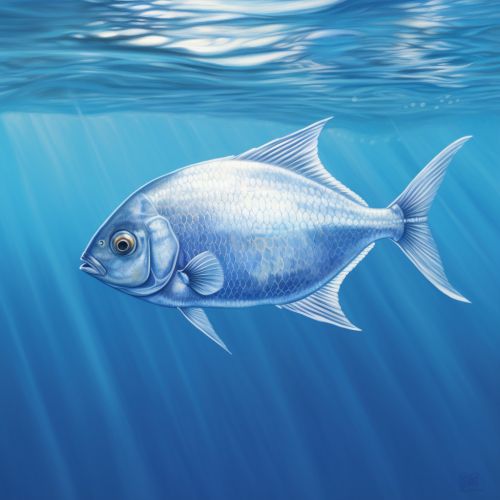Giant trevally
Taxonomy and naming
The Giant trevally (Caranx ignobilis), also known as the lowly trevally, is a species of large marine fish in the jack family, Carangidae. The species' name 'ignobilis' is derived from Latin, meaning 'unknown' or 'unrecognized', which refers to its late official recognition as a species.
Description
The Giant trevally is a large fish, growing to a maximum known size of 170 cm and a weight of 80 kg. The body of the Giant trevally is oblong and compressed, with the dorsal profile more convex than the ventral profile. The upper jaw has an irregular row of outer canines with an inner band of smaller teeth, while the lower jaw has small conical teeth. The dorsal fin is in two parts, the first consisting of eight spines and the second of one spine followed by 18 to 21 soft rays. The anal fin consists of two anteriorly detached spines followed by one spine and 15 to 17 soft rays. The pelvic fins contain one spine and 19 to 20 soft rays. The caudal fin is strongly forked, and the pectoral fins are falcate, being longer than the length of the head. The lateral line has a pronounced and moderately long anterior arch, with the curved section intersecting the straight section below the lobe of the second dorsal fin. The straight section contains 0 to 4 scales, followed by 46 to 50 strong scutes. The chest is devoid of scales with the exception of a small patch of scales in front of the pelvic fins. The upper body is blue to silvery, while the lower body is silvery-white, with the head having a dusky coloration. Juveniles have a series of dark bars on their sides.


Distribution and habitat
The Giant trevally is distributed throughout the tropical waters of the Indo-Pacific region, from South Africa in the west to Hawaii in the east, including Japan in the north and Australia in the south. It is also found in the eastern Pacific, from the Gulf of California to Colombia. The species is most commonly found in coastal waters, particularly around coral reefs, but can also be found in brackish water. Juveniles prefer the protection of estuaries and mangrove forests, while adults are found in a variety of habitats, including bays, sandy beaches, rocky reefs, and offshore atolls and islands.
Behavior and ecology
The Giant trevally is a powerful predator in most of its habitats, and is known to hunt individually and in schools. The species has a reputation for its strength and endurance in the fight while being hooked, making it a highly prized game fish. The diet of the Giant trevally primarily consists of other fish, but crustaceans, cephalopods, and occasionally birds falling to the water surface are also taken. The species is an apex predator in most of its habitats, and is known to even attack sharks in Hawaiian waters. Reproduction occurs in the warmer months, with peaks often observed in the full moons of the warmer part of the year. The species is known to spawn in specific areas, often around the new and full moons, with breeding pairs producing thousands of eggs each breeding season. The eggs and larvae are pelagic, with the larvae and small juveniles often found in estuaries and embayments before moving offshore as they mature.
Human interaction
The Giant trevally has been used by humans since prehistoric times, with archaeological evidence from the Pacific Islands suggesting human consumption dating back over 7000 years. The species has also been farmed, with juveniles being caught and raised until maturity in floating net cages. The species is considered of good to excellent quality table fare by anglers. The Giant trevally is also highly sought after by sport fishers, particularly fly fishers, due to its speed and strength. The species' edibility has been rated from poor to excellent, with some suggesting the smaller fish are the best eating. The fish is considered a premier gamefish in its range, with the fight consisting of several strong runs and sometimes leaps out of the water.
Conservation
The Giant trevally is not currently considered at risk, with the IUCN (International Union for Conservation of Nature) listing it as 'Least Concern'. However, the species' popularity with anglers and its slow growth rate have led to concerns about overfishing. Some countries, such as Australia, have implemented size and bag limits for the species in an attempt to ensure sustainable fishing practices.
